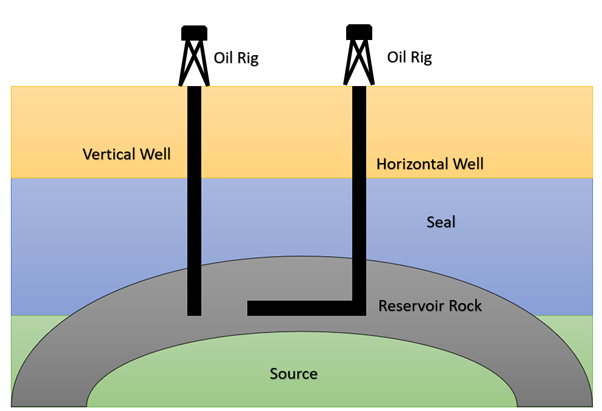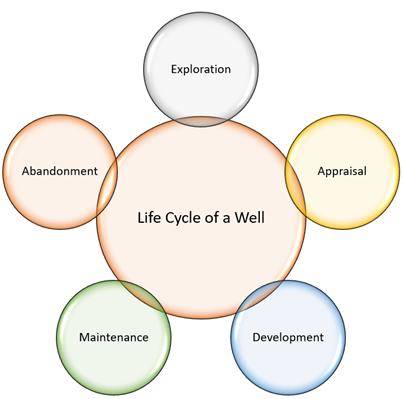An oil well is a hole drilled from the Earth's surface to the oil reservoir for the extraction of hydrocarbons. Usually, oil wells produce both crude oil and associated natural gas. Wells with different trajectories can be drilled to extract hydrocarbons from the subsurface. So, an oil well could be a directional, vertical or horizontal well. Wells are drilled with the help of complex drilling equipment assembled to form a megastructure, i.e. oil rig.
Type of Oil & Gas Well:
The general classification of an oil well is based on the well-being drilled or planned for drilling. If the well is located on land, it is known as an onshore well, or if it is located in an offshore location or an ocean, it is termed as an offshore well. The operating and drilling cost for an offshore well is far more than an onshore well.

Copyright © 2021 Kalkine Media Pty Ltd
The other classification of wells can be made based on their trajectory. The most common type of well that is drilled nowadays is Conventional wells. These wells are conventionally drilled vertically downward, starting above the location of the reservoir. These wells may have a slight deviation which steerable devices can achieve during the course of drilling. The cost of drilling conventional wells is relatively cheaper than other wells. Other wells in the cadre are horizontal wells which are drilled for a better yield from the reservoir. These well can stimulate the reservoir in a better way than conventional well after striking the reservoir in a nearly horizontal manner.
Life Cycle of an Oil Well:
The whole life cycle of a well is broadly classified into five main chapters starting from the planning stage, where the planning for drilling a well is being undertaken. However, the last stage in the life of a well is abandonment, when the well is plugged off. Let us discuss all five stages in brief.

Copyright © 2021 Kalkine Media Pty Ltd
- Exploration: Exploration is the first and basic stage of a company's efforts towards drilling a well. Companies undertake exploration activities to understand the presence of hydrocarbons in a particular reservoir. The exploratory phase involves the search for rock formations containing oil and gas with the help of geophysical surveys and exploration drillings. The wells drilled during this phase are also known as wildcat wells. Once the exploratory drill hits the oil and gas reservoir, the well proceeds for the appraisal phase.
- Appraisal: In the appraisal phase of drilling a well, delineation wells are drilled into the area to delineate the reservoir's extent. The process may take several years. The geoscientists analyze the data obtained during the appraisal phase to understand either the production from the reservoir is economically viable or not. Geological modelling is being undertaken into this phase to estimate the reserve volume. Companies enter into a production sharing agreement in several countries after deciding to develop reserves based on exploration and appraisal results.
- Development: After doing a proper assessment of data from the appraisal phase and calculating the volume of hydrocarbons, if the company finds it economically feasible to develop the field, then they proceed for development. More wells are drilled into the field in the development phase, up to greater depths than the exploration and appraisal phase. Development wells are drilled for the production of hydrocarbons. The company intends to maximize its production output in this phase. Hydrocarbons are extracted from the reservoir in this step.
- Maintenance: This is the recovery phase in the life cycle of a well after the rate of production starts declining after a certain duration. The production rate starts declining after a certain period because of the decline in reservoir pressure. The oil well is reactivated by different mechanisms to enhance the production from the well. The well is flooded with steam that is injected into the reservoir to increase the reservoir pressure. This is a very significant step to increase the life of a well.
- Abandonment: Finally, the abandonment stage comes when the well is plugged and abandoned. This stage comes after the production from the well becomes uneconomical. The well is not able to produce economic quantities of hydrocarbon from the well.
Other types of Oil Wells:
Exploration, appraisal and development are the most common types of wells that are drilled in the oil and gas industry, but due to the uncertainty in drilling, there are some other types of wells that are drilled to counterbalance the complexities of the geology.
- Sidetrack Wells: Sidetrack is a second well that is drilled parallel to the original well from the same drilling pad, away from an original hole. Sidetracks are used to bypass an unusable section of a well that may be inaccessible due to irretrievable fish or a collapsed borehole. The sidetrack can also be used to explore a nearby geological feature.
- Relief Wells: Relief wells are drilled to control the sudden explosion of an O&G well. This is a second well drilled at a distance from the original hole. The well is used to balance the over-pressurized formation fluids flowing into the original hole. High-density drilling mud is pumped into the hole to over balancing the high-pressured formation fluids. The wells are capable of avoiding sand boils.
- Injection Wells: Injection wells are used to pump gas or water into the reservoir to lift the reservoir pressure and increase the production rate. Separated gas from production is usually used in the injection process. Water injection wells are common offshore, where seawater is reinjected into the borehole after proper filtering and treatment.
 Please wait processing your request...
Please wait processing your request...